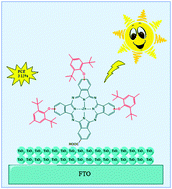A new sterically hindered asymmetric zinc phthalocyanine as an efficient sensitizer for dye-sensitized solar cells†
Abstract
An asymmetric zinc phthalocyanine dye (KH1) bearing three 2,6-di-tert-butyl-4-methylphenoxy donor groups and one carboxylic acid anchoring group was synthesized as a sensitizer for dye-sensitized solar cells (DSSCs). The DSSC based on KH1 showed a 3.12% power conversion efficiency (PCE) under AM 1.5G conditions. Upon addition of chenodeoxycholic acid (CDCA) as a coadsorbent, the PCE slightly enhanced to 3.21%, probably because the bulky donor groups on the dye can efficiently inhibit dye aggregation. Furthermore, this blue dye (KH1) was also applied to combine with a commercially available red-brown metal-free organic dye (RK1) for a co-sensitized DSSC, which exhibited an improved PCE of 6.67% than RK1 alone (5.75%). Theoretical calculations based on density functional theory (DFT) (B3LYP/def2-SVP) and time-dependent DFT (TPSSh/def2-SVP) were performed to study the structural, electronic and optical properties of eight isomers of KH1. We found that the isomers are nearly isoenergetic structures (0.38–1.07 kcal mol−1) and the electronic absorption spectra show two strong Q bands in the visible region (625–660 nm) and a less intense B band in the UV region (345–350 nm) for all the isomers, in agreement with the UV-Vis spectrum with deviations of up to 0.15 eV. Excited states that show a contribution of the carboxyl moiety in the unoccupied MOs at regions of 370–420 nm and 650 nm suggest that electron injection into the semiconductor would be favored at these wavelengths. These results are coherent with the IPCE values determined in this study for KH1 where the maximum values are near to 400 nm and 690 nm. The adsorption of each of the isomers on a TiO2 cluster was analyzed resulting in energetically favorable complexes. The results demonstrate that the co-sensitization of phthalocyanine and organic dyes may lead to further improvement of photovoltaic performance. In addition, theoretical calculations may provide a molecular comprehension of the electronic and optical properties of the dyes.



 Please wait while we load your content...
Please wait while we load your content...